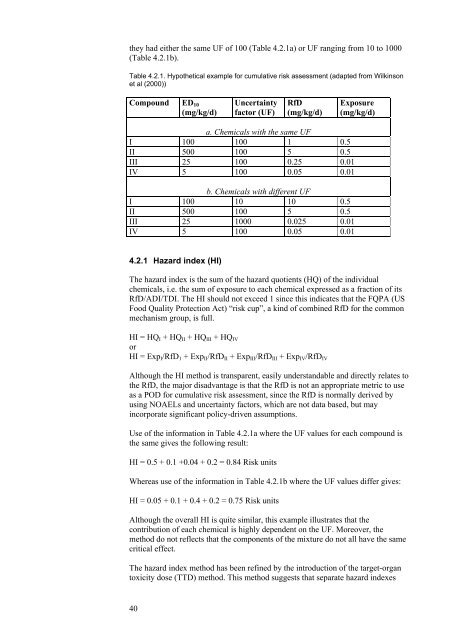Combined Actions and Interactions of Chemicals in Mixtures
Combined Actions and Interactions of Chemicals in Mixtures
Combined Actions and Interactions of Chemicals in Mixtures
Create successful ePaper yourself
Turn your PDF publications into a flip-book with our unique Google optimized e-Paper software.
they had either the same UF <strong>of</strong> 100 (Table 4.2.1a) or UF rang<strong>in</strong>g from 10 to 1000<br />
(Table 4.2.1b).<br />
Table 4.2.1. Hypothetical example for cumulative risk assessment (adapted from Wilk<strong>in</strong>son<br />
et al (2000))<br />
Compound ED10<br />
(mg/kg/d)<br />
40<br />
Uncerta<strong>in</strong>ty<br />
factor (UF)<br />
RfD<br />
(mg/kg/d)<br />
a. <strong>Chemicals</strong> with the same UF<br />
I 100 100 1 0.5<br />
II 500 100 5 0.5<br />
III 25 100 0.25 0.01<br />
IV 5 100 0.05 0.01<br />
b. <strong>Chemicals</strong> with different UF<br />
I 100 10 10 0.5<br />
II 500 100 5 0.5<br />
III 25 1000 0.025 0.01<br />
IV 5 100 0.05 0.01<br />
4.2.1 Hazard <strong>in</strong>dex (HI)<br />
Exposure<br />
(mg/kg/d)<br />
The hazard <strong>in</strong>dex is the sum <strong>of</strong> the hazard quotients (HQ) <strong>of</strong> the <strong>in</strong>dividual<br />
chemicals, i.e. the sum <strong>of</strong> exposure to each chemical expressed as a fraction <strong>of</strong> its<br />
RfD/ADI/TDI. The HI should not exceed 1 s<strong>in</strong>ce this <strong>in</strong>dicates that the FQPA (US<br />
Food Quality Protection Act) “risk cup”, a k<strong>in</strong>d <strong>of</strong> comb<strong>in</strong>ed RfD for the common<br />
mechanism group, is full.<br />
HI = HQI + HQII + HQIII + HQIV<br />
or<br />
HI = ExpI/RfD1 + ExpII/RfDII + ExpIII/RfDIII + ExpIV/RfDIV<br />
Although the HI method is transparent, easily underst<strong>and</strong>able <strong>and</strong> directly relates to<br />
the RfD, the major disadvantage is that the RfD is not an appropriate metric to use<br />
as a POD for cumulative risk assessment, s<strong>in</strong>ce the RfD is normally derived by<br />
us<strong>in</strong>g NOAELs <strong>and</strong> uncerta<strong>in</strong>ty factors, which are not data based, but may<br />
<strong>in</strong>corporate significant policy-driven assumptions.<br />
Use <strong>of</strong> the <strong>in</strong>formation <strong>in</strong> Table 4.2.1a where the UF values for each compound is<br />
the same gives the follow<strong>in</strong>g result:<br />
HI = 0.5 + 0.1 +0.04 + 0.2 = 0.84 Risk units<br />
Whereas use <strong>of</strong> the <strong>in</strong>formation <strong>in</strong> Table 4.2.1b where the UF values differ gives:<br />
HI = 0.05 + 0.1 + 0.4 + 0.2 = 0.75 Risk units<br />
Although the overall HI is quite similar, this example illustrates that the<br />
contribution <strong>of</strong> each chemical is highly dependent on the UF. Moreover, the<br />
method do not reflects that the components <strong>of</strong> the mixture do not all have the same<br />
critical effect.<br />
The hazard <strong>in</strong>dex method has been ref<strong>in</strong>ed by the <strong>in</strong>troduction <strong>of</strong> the target-organ<br />
toxicity dose (TTD) method. This method suggests that separate hazard <strong>in</strong>dexes

















